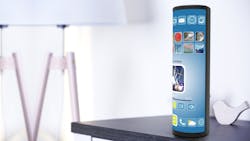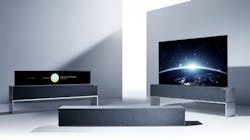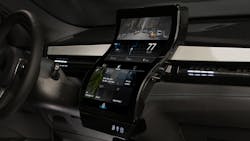Flexible Displays: From Conformables to Foldables
This article is part of TechXchange: Advanced Display Technology
What you’ll learn:
- What is a flexible display?
- Applications that demand flexible displays.
- Things to consider when choosing a flexible-display technology.
Since the development of flat-panel displays, products often had to be designed around the flat display, so it’s easy to forget that glass display component is a major design constraint. In a car, for example, the only remaining flat surface is usually the integrated display—every other surface is curved. Car designers today are looking for non-flat and non-rectangular displays to enable their seamless integration into the vehicle interior.
Smart speakers, on the other hand, often have cylindrical shapes and need wraparound displays, while other smart-home devices would benefit from curved displays with holes to accommodate additional design features.
What Is a Flexible Display?
The term flexible display is used in a variety of ways. For some, it means displays that are able to be flexed during use; for others it means displays that are flexed in the product housing, such as a curved glass TV. The most common definition of flexible displays is displays manufactured on plastic substrates. That means at some point during the manufacturing process the display was flexible, even if it’s finally laminated onto a rigid cover glass before being integrated into the product housing.
Conformable displays are flexible during production but should be conformed to or wrapped around surfaces in a fixed curved shape in the final product. These displays offer a degree of design freedom that is not possible with flat glass-based displays.
One example of a conformable display is FlexEnable’s organic LCD (OLCD) on plastic, which can be wrapped around surfaces with a bend radius down to 10 mm (Fig. 1). OLCDs can also be easily cut to different shapes by laser profiling, enabling non-rectangular displays and displays with holes, otherwise known as shapeable displays.
Shapeable display is a less popular term that refers not to the flexibility, but to the ability to design and cut displays into unusual (non-rectangular) shapes, whether or not they are then subsequently conformed, folded or rolled.
The term foldable display is generally used to describe a display that can be tightly bent at 180 degrees on top of itself repeatedly. Foldable displays have been much talked about in the last few years thanks to some phone manufacturers’ efforts to differentiate themselves from the competition by launching innovative smartphone designs.
Rollable displays refer to displays that can be rolled like a newspaper to at least 20-mm radius of curvature or less. Recently, LG launched its 65-in. rollable organic light-emitting diode (OLED) TV on the market with an astonishing $87,000 price tag (Fig. 2).
Foldable and rollable displays are still difficult and expensive to manufacture, but the good news is that most products don’t require displays that must be flexed, folded, or rolled during use. For example, applications such as automotive interiors, smart-home devices, and in-store digital signage need displays that can be fixed to the curved surfaces of the products.
Things to Consider
Not all flexible-display technologies would meet every product requirement. Flexible OLED is currently the only display technology that enables foldable phones and rollable TVs. However, it’s less suitable for automotive displays due to its lower reliability and significantly higher manufacturing costs (in particular for large displays) compared with OLCD.
Let’s take a look at some of the key characteristics that engineers should consider when choosing a display technology.
Design and Ergonomics
The aesthetics of the product are often determined by the display. Flexible displays offer exciting opportunities to product designers, allowing the display to follow the surface contours of the product housing. Moreover, there’s a trend for truly bezel-less designs, which is observed not only in smartphones, but also in notebooks, tablets and even TVs.
Flexible OLED has been used for several years to deliver bezel-less displays in smartphones by partially curving the display around the side of the product. OLCD offers an alternative approach that’s particularly suited to large-area applications such as notebooks—it makes it possible for the display to be borderless by folding the edges away.
In the case of OLCD, it’s also easy to make apertures—physical holes—within the screen itself, enabling seamless integration of the display with other functions. Consumers often make their buying decision based on the aesthetics of a product, and there’s huge potential to change the form of products in ways never previously imagined. Holes can be cut in the display during production without affecting performance, offering straightforward integration of anything from speakers and cameras to watch hands and toggle switches.
Even the most beautiful aesthetics in the world will soon be forgotten if the product is difficult or irritating to use. Flexible displays, if applied well, can improve the product ergonomics. They can allow wearable devices to sit more comfortably around your body, for example, or allow larger infotainment displays to be incorporated into vehicles, making them easier to view without sacrificing space for passengers. And, of course, plastic screens will also make tablets and laptops much lighter to carry.
Performance
Some of the most important factors for the wide adoption of flexible displays into products are their performance and longevity. For flexible displays to replace their rigid glass counterparts, they must achieve the same reliability standards as well as prove that they can perform equally well when they’re conformed and shaped.
The reliability of flexible displays depends strongly on the materials used to make them. While both organic and inorganic materials can be used for making flexible displays, many organic materials have the advantage of being inherently flexible. Over the last few years, the performance of these materials has improved immensely, allowing for their commercial application.
Organic materials are commonly known for their use in OLED displays, but they’re also used as semiconductor materials to make high-performance organic thin-film transistors (OTFTs). OTFTs can be then combined with a well-established and mature liquid-crystal frontplane technology to create OLCDs.
All display types need to go through rigorous reliability testing to prove they’re commercially viable. For example, shock temperature tests of the displays must be done to ensure that they’re suitable for the end product. New testing sequences also need to be developed that are relevant to the specific application and use case. Different tests will be required depending on whether the display needs to withstand a single bend or multiple bends, and the effect of the impact at different locations on a bent display has to be tested, too.
Display lifetime is an important performance consideration for many applications where the display is embedded. For example, home appliances might be expected to last for a decade, but displays used in automotive applications need to last as long as the vehicle.
While OLED is known for its high contrast and resolution, today’s flexible OLED displays struggle to meet the lifetime requirements for automotive applications. This issue is exacerbated by the high level of brightness required in cars, as it directly impacts on the lifetime of OLED pixels.
By sharing many of the components of traditional LCD displays (as well as the supply chain), OLCDs have no tradeoff in screen performance compared to their glass counterparts. They’re robust enough to deal with vibrations and large temperature variations, and can be made bright enough for outdoor use without compromising lifespan, making them ideal for use in vehicles as well as consumer electronics (Fig. 3).
Integration
Mechanical integration of flexible displays is a new consideration over glass displays—it’s important that the display is rugged and resilient to the lamination or forming processes that are undertaken to achieve a complete “surface integrated display.” Conversely, it’s equally important that from an electrical integration standpoint, the display looks just like a glass display, using the same interfaces, protocol and voltage ranges, to minimize barriers to adoption for both existing and new applications. Both OLED and OLCD use standard interfaces for driving.
Costs
Currently, flexible OLED displays are expensive to manufacture, which is why they’re generally only seen in high-end products, such as flagship smartphones and smart watches. Costs will, of course, come down over time, but this issue will be exacerbated for larger display sizes, making it difficult to use this technology in mass-market applications such as home appliances, laptops, or TVs for the foreseeable future.
OLCDs have been developed specifically with this issue in mind. Using a display structure similar to traditional glass-based LCDs, the technology allows large display sizes to be made cost-effectively. This makes it feasible to create flexible, conformable displays for use in a wide range of applications, providing huge differentiation and margin opportunities through the supply chain.
The Future
Not all applications will require all display properties described in this article. For example, automotive displays need to be conformable and shapeable, but not really foldable, whereas a foldable tablet or phone could change the user experience and utility of mobile devices.
In the next few years, we will start to see flexible displays in nearly all applications where glass displays are used today. In addition, many new uses are possible, but only if displays can be wrapped around existing, non-flat surfaces.
Read more articles in TechXchange: Advanced Display Technology
About the Author

Paul Cain
Strategy Director, FlexEnable
Paul Cain, strategy director at FlexEnable, has 20 years of experience in flexible and organic electronics, both in technical and strategic roles. Paul has a PhD in physics from the University of Cambridge and an MBA from London Business School.



